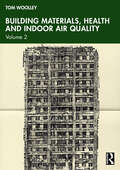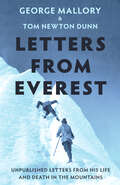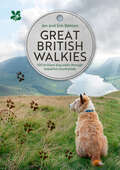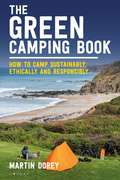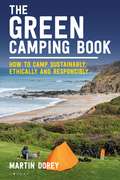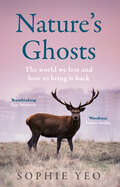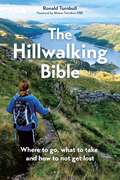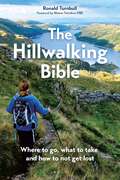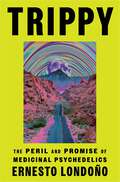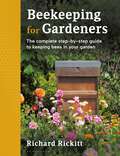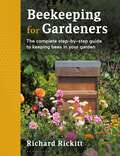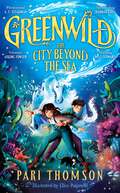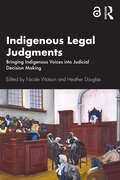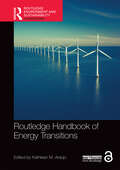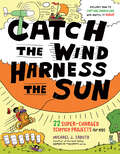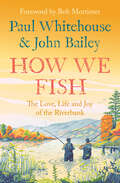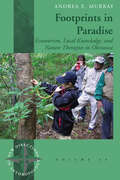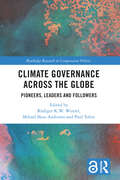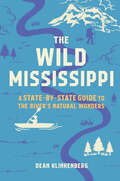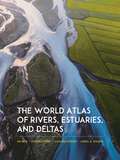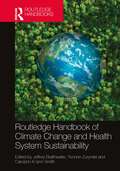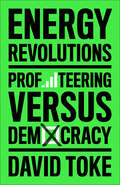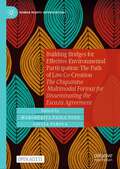- Table View
- List View
Building Materials, Health and Indoor Air Quality: Volume 2
by Tom WoolleyIn Building Materials, Health and Indoor Air Quality: Volume 2 Tom Woolley uses new research to continue to advocate for limiting the use of hazardous materials in construction and raise awareness of the links between pollutants found in building materials, poor indoor air quality and health problems. Chapters in this volume reinforce previous arguments and present new ones covering: Further evidence of the health impacts of hazardous emissions from materials Hazardous materials to be avoided and why Fire and smoke toxicity – the Lakanal House and Grenfell Tower legacy Sub-standard retrofits leading to damp and mould in previously sound houses A critical review of recent reports from UK Government and others on air quality and health problems including policy changes on flame retardants Growing evidence of cancer risks and the failure of cancer research organisations to address these issues A critical review of recent climate change and zero carbon policies and a discussion on whether extreme energy efficiency is a good thing This book asks some important and, for some, uncomfortable questions, but in doing so it brings to light important areas for research and provides much needed guidance for architects, engineers, construction professionals, students and researchers on hazardous materials and how to reduce their use and design and build healthier buildings for all occupants.
Building Materials, Health and Indoor Air Quality: Volume 2
by Tom WoolleyIn Building Materials, Health and Indoor Air Quality: Volume 2 Tom Woolley uses new research to continue to advocate for limiting the use of hazardous materials in construction and raise awareness of the links between pollutants found in building materials, poor indoor air quality and health problems. Chapters in this volume reinforce previous arguments and present new ones covering: Further evidence of the health impacts of hazardous emissions from materials Hazardous materials to be avoided and why Fire and smoke toxicity – the Lakanal House and Grenfell Tower legacy Sub-standard retrofits leading to damp and mould in previously sound houses A critical review of recent reports from UK Government and others on air quality and health problems including policy changes on flame retardants Growing evidence of cancer risks and the failure of cancer research organisations to address these issues A critical review of recent climate change and zero carbon policies and a discussion on whether extreme energy efficiency is a good thing This book asks some important and, for some, uncomfortable questions, but in doing so it brings to light important areas for research and provides much needed guidance for architects, engineers, construction professionals, students and researchers on hazardous materials and how to reduce their use and design and build healthier buildings for all occupants.
Letters From Everest: Unpublished Letters from Mallory’s Life and Death in the Mountains
by null Tom Newton DunnA unique collection of unpublished letters from the climbing legend George Mallory to his family, revealing his innermost thoughts about people, places and mountains. On the 8th of June, 1924, George Mallory and Sandy Irvine were seen through a telescope on the upper slopes of Mount Everest. They were never seen alive again. In 1999, Mallory’s body was found below the ridge where he was last seen. In the 100 years since his disappearance, many words have been written about Mallory, but very little has ever been published of his own thoughts. Letters from Everest is an eye opening set of personal letters from Mallory to his family, recently discovered hidden in a drawer. In the letters, Mallory is completely open about his life, his climbing and especially the three Everest Expeditions he was a part of – 1921, 1922 and the last in 1924. His writing is full of extraordinary insights – most of which have never been published in any form. They are a unique collection – an actual reflection, possibly the one and only, of the thoughts of a climbing legend who walked into history a century ago.
Great British Walkies (National Trust)
by National Trust BooksDog-friendly country walks in Britain with places to eat and stay Supported by the National Trust, and includes their ‘pawprint rating’ system for dog-friendly places Breathtaking walks that aren’t too challenging – 2-6 miles in length. Suggested stops. Walks are created with dogs in mind – all the info you need. Don’t just take your dog for a walk. Take your dog for one of Britain’s 100 best dog walks. These country routes are custom-made for you and your four-legged friend. Ranging from 2 to 6 miles, they cover the whole of the UK and take some of our most beautiful woods, coast, rolling hills and fields, not to mention fascinating and inspiring historic sites. For each walk, there’s a map and comprehensive directions, plus information on whether and where a lead is needed and suggestions for dog-friendly refreshment stops and accommodation nearby.
The Green Camping Book: How to camp sustainably, ethically and responsibly
by Mr Martin DoreyFrom Martin Dorey - lifelong camper, campervanner and committed environmentalist - a manifesto on how to camp greener and more responsibly while enjoying the outdoors.Planet earth is in crisis. Climate change is affecting everyone, and everyone has a responsibility to do all they can to make things better, including campers and campervanners. In fact, it often falls to us to protect our spaces and fight to keep them the way we like them.This book shows us how we can do it. The Green Camping Book signposts you towards making more sustainable choices about kit, where to stay, how to travel, what to wear, and what we can keep doing to fight for green spaces we love. It is a book for people who want to reduce their impact and carbon footprint but don't want to stop exploring. It is for people who want to get out, off the sofa, and into the wilderness without doing it further damage. It is for people who think they could do more, but don't know how. It asks of everyone who likes spending time outdoors to think about their impact and to take urgent, important steps to soften their footprint on the world.
The Green Camping Book: How to camp sustainably, ethically and responsibly
by Mr Martin DoreyFrom Martin Dorey - lifelong camper, campervanner and committed environmentalist - a manifesto on how to camp greener and more responsibly while enjoying the outdoors.Planet earth is in crisis. Climate change is affecting everyone, and everyone has a responsibility to do all they can to make things better, including campers and campervanners. In fact, it often falls to us to protect our spaces and fight to keep them the way we like them.This book shows us how we can do it. The Green Camping Book signposts you towards making more sustainable choices about kit, where to stay, how to travel, what to wear, and what we can keep doing to fight for green spaces we love. It is a book for people who want to reduce their impact and carbon footprint but don't want to stop exploring. It is for people who want to get out, off the sofa, and into the wilderness without doing it further damage. It is for people who think they could do more, but don't know how. It asks of everyone who likes spending time outdoors to think about their impact and to take urgent, important steps to soften their footprint on the world.
Nature’s Ghosts: The world we lost and how to bring it back
by null Sophie YeoWhat history can teach us about how to avoid ecological catastrophe ‘Sophie writes fantastically, chronicling the most important issues facing nature conservationists today.’ Chris Packham For thousands of years, humans have been the architects of the natural world. Our activities have permanently altered the environment – for good and for bad. In Nature’s Ghosts, award-winning journalist Sophie Yeo examines how the planet would have looked before humans scrubbed away its diversity: from landscapes carved out by megafauna to the primeval forests that emerged following the last Ice Age, and from the eagle-haunted skies of the Dark Ages to the flower-decked farms of more recent centuries. Uncovering the stories of the people who have helped to shape the landscape, she seeks out their footprints even where it seems there are none to be found. And she explores the timeworn knowledge that can help to fix our broken relationship with the earth. Along the way, Sophie encounters the environmental detectives – archaeological, cultural and ecological – reconstructing, in stunning detail, the landscapes we have lost. Today, the natural world is more vulnerable than ever; the footprints of humanity heavier than they have ever been. But, as this urgent book argues, from the ghosts of the past, we may learn how to build a more wild and ancient future.
The Hillwalking Bible: Where to go, what to take and how to not get lost
by Ronald TurnbullThis is the definitive reference to hillwalking for all walkers with everything they need to know to explore the countryside with confidence. Whether it's fellwalking, hillwalking, hiking or simply going for a stroll – a walk in some wild country is the world's favourite leisure activity. The British Isles, with our green and craggy hills, heather moors, silver rivers and thousands of miles of beautiful coastline, is one of the best places in the world to go walking.If you're in search of new adventures, invaluable advice and handy tips, The Hillwalking Bible is for you. This instructional manual gives a complete rundown on the gear you need and how to navigate with a compass, map and mobile phone. It includes advice on where and when to go, long distance walking, backpacking, wild camping, and walking abroad. As a respected author of walking guides, Ronald Turnbull brings together a lifetime of expert knowledge that'll improve your walks, big or small, with advice on scrambling, walking with children and dogs, and dealing with different weather conditions and emergencies. Ronald also includes 16 of his favourite walking routes, with stunning photography and maps, from the valleys of the Peak District to the Scottish Highlands. This book will encourage you to head out, feet first, into the hills and the wilderness of the UK's enchanted isles.
The Hillwalking Bible: Where to go, what to take and how to not get lost
by Ronald TurnbullThis is the definitive reference to hillwalking for all walkers with everything they need to know to explore the countryside with confidence. Whether it's fellwalking, hillwalking, hiking or simply going for a stroll – a walk in some wild country is the world's favourite leisure activity. The British Isles, with our green and craggy hills, heather moors, silver rivers and thousands of miles of beautiful coastline, is one of the best places in the world to go walking.If you're in search of new adventures, invaluable advice and handy tips, The Hillwalking Bible is for you. This instructional manual gives a complete rundown on the gear you need and how to navigate with a compass, map and mobile phone. It includes advice on where and when to go, long distance walking, backpacking, wild camping, and walking abroad. As a respected author of walking guides, Ronald Turnbull brings together a lifetime of expert knowledge that'll improve your walks, big or small, with advice on scrambling, walking with children and dogs, and dealing with different weather conditions and emergencies. Ronald also includes 16 of his favourite walking routes, with stunning photography and maps, from the valleys of the Peak District to the Scottish Highlands. This book will encourage you to head out, feet first, into the hills and the wilderness of the UK's enchanted isles.
Trippy: The Peril and Promise of Medicinal Psychedelics
by Ernesto LondoñoA moving, tender and thoughtful exploration of a complicated subject. Johann Hari, Sunday Times bestselling author of Stolen Focus and Lost ConnectionsA compulsively readable romp through a burgeoning scene that has immense potential for both harm and healing.Dan Harris, New York Times bestselling author of 10% Happier and host of the Ten Percent Happier podcastCourageous and revelatory... This journey inside the brain and around the world taught me more than any book I've read in a long time. It's an important book, one that will save people's lives.Benjamin Moser, Pulitzer Prize winning author of Sontag: Her Life and WorkWhen he signed up for a psychedelic retreat deep in the Brazilian rainforest, veteran New York Times journalist Ernesto Londoño was so depressed that he had come close to attempting suicide just weeks earlier. To his astonishment, the nine-day ayahuasca experience provided Londoño an instant reprieve from his depression and became the genesis of a personal transformation that anchors this sweeping exploration of the booming field of medicinal psychedelics. Londoño's deeply researched and brilliantly reported account introduces readers to a dazzling array of psychedelic enthusiasts who are upending our understanding of trauma and healing. From Indigenous elders who regard psychedelics as portals to the spirit world to religious leaders using mind-bending substances as sacraments, as well as war veterans who credit psychedelics with alleviating their PTSD, and clinicians trying to resurrect a promising field of medicine hastily abandoned in when the War on Drugs was announced in the 1970s.Trippy is the definitive book of psychedelics and mental health today, an in-depth and nuanced look at this booming industry which makes sense of the perils, limitations and promise of turning to psychedelics in the pursuit of healing.
Beekeeping for Gardeners: The complete step-by-step guide to keeping bees in your garden
by Richard RickittA comprehensive gardener's guide to sustainable beekeeping.Beekeeping has changed. While once it was a hobby that pursued the rich rewards of honey and wax, many new beekeepers now instead seek the gratification of knowing that they are aiding the survival of one of the world's most important creatures. Keeping bees today is as much about providing the right habitats and resources to help pollinators thrive as it is about chasing every drop of golden honey.This beautifully illustrated guide to the ancient hobby of beekeeping shows today's gardeners how to create beautiful gardens that are richly rewarding for people and bees alike. Flowers, shrubs, trees and vegetable plots can provide colourful beauty and delicious produce as well as vital pollen and nectar when bees need it the most. There are lists of the top-performing plants and how and where to grow them, including window boxes, lawns, borders, wild gardens and even ponds.Beekeeping for Gardeners looks at the pleasures and benefits of keeping honey bees in gardens of all types and sizes, both rural and urban. It explains the practicalities involved in keeping bees in the domestic garden setting, as well as on rooftops, allotments, parks, farmland and other locations. Importantly, and unlike any book before, this guide sets the delightful hobby of beekeeping within the context of the wider environment, asking how it can best serve the needs of all types of pollinator and the local ecology in general.Whether you're looking to attract more bumblebees and solitary bees or want to install a beehive, this wonderful book contains all the guidance you'll need to have a garden buzzing with bees.
Beekeeping for Gardeners: The complete step-by-step guide to keeping bees in your garden
by Richard RickittA comprehensive gardener's guide to sustainable beekeeping.Beekeeping has changed. While once it was a hobby that pursued the rich rewards of honey and wax, many new beekeepers now instead seek the gratification of knowing that they are aiding the survival of one of the world's most important creatures. Keeping bees today is as much about providing the right habitats and resources to help pollinators thrive as it is about chasing every drop of golden honey.This beautifully illustrated guide to the ancient hobby of beekeeping shows today's gardeners how to create beautiful gardens that are richly rewarding for people and bees alike. Flowers, shrubs, trees and vegetable plots can provide colourful beauty and delicious produce as well as vital pollen and nectar when bees need it the most. There are lists of the top-performing plants and how and where to grow them, including window boxes, lawns, borders, wild gardens and even ponds.Beekeeping for Gardeners looks at the pleasures and benefits of keeping honey bees in gardens of all types and sizes, both rural and urban. It explains the practicalities involved in keeping bees in the domestic garden setting, as well as on rooftops, allotments, parks, farmland and other locations. Importantly, and unlike any book before, this guide sets the delightful hobby of beekeeping within the context of the wider environment, asking how it can best serve the needs of all types of pollinator and the local ecology in general.Whether you're looking to attract more bumblebees and solitary bees or want to install a beehive, this wonderful book contains all the guidance you'll need to have a garden buzzing with bees.
Greenwild: The City Beyond the Sea (Greenwild #2)
by Pari ThomsonAcross the ocean, a magical adventure awaits in The City Beyond the Sea, the spellbinding, beautifully-illustrated sequel to Overall Waterstones Children's Book Prize winner and Blackwell's Children's Book of the Year, Greenwild: The World Behind the Door by Pari Thomson.'Phenomenal . . . If you don’t believe in magic, you will after you’ve read Greenwild' - A. F. Steadman, author of the Skandar series'A spectacular, sweeping fantasy filled with intrigue - secret cities, magic, and mystery . . . a book bursting with heart and courage' - Rashmi Sirdeshpande Daisy Thistledown is on a mission. She might have defeated a terrible enemy, but her journey to find her kidnapped mother is just beginning. After smuggling aboard a long-awaited expedition to the heart of theAmazon, Daisy and her friends soon find themselves in danger on the high seas, pursued across the waves by Grim Reapers. Their only hope: to find the legendary Iffenwild, a mysterious city hidden beyond the sea and lost to time.But a strange, wild magic is stirring beneath the waves. It will take all of Daisy’s courage and determination – and the trust of a new friend – if she is to discover the truth that haunts Iffenwild, and save the magical world before it’s too late.'An eco-thriller every child should read' - The Telegraph on Greenwild: The World Behind the Door
Indigenous Legal Judgments: Bringing Indigenous Voices into Judicial Decision Making
by Nicole Watson and Heather DouglasThis book is a collection of key legal decisions affecting Indigenous Australians, which have been re-imagined so as to be inclusive of Indigenous people’s stories, historical experience, perspectives and worldviews.In this groundbreaking work, Indigenous and non-Indigenous scholars have collaborated to rewrite 16 key decisions. Spanning from 1889 to 2017, the judgments reflect the trajectory of Indigenous people’s engagements with Australian law. The collection includes decisions that laid the foundation for the wrongful application of terra nullius and the long disavowal of native title. Contributors have also challenged narrow judicial interpretations of native title, which have denied recognition to Indigenous people who suffered the prolonged impacts of dispossession. Exciting new voices have reclaimed Australian law to deliver justice to the Stolen Generations and to families who have experienced institutional and police racism. Contributors have shown how judicial officers can use their power to challenge systemic racism and tell the stories of Indigenous people who have been dehumanised by the criminal justice system.The new judgments are characterised by intersectional perspectives which draw on postcolonial, critical race and whiteness theories. Several scholars have chosen to operate within the parameters of legal doctrine. Some have imagined new truth-telling forums, highlighting the strength and creative resistance of Indigenous people to oppression and exclusion. Others have rejected the possibility that the legal system, which has been integral to settler-colonialism, can ever deliver meaningful justice to Indigenous people.The Open Access version of this book, available at http://www.taylorfrancis.com, has been made available under a Creative Commons Attribution-Non Commercial-No Derivatives (CC-BY-NC-ND) 4.0 license.
Routledge Handbook of Energy Transitions (Routledge Environment and Sustainability Handbooks)
by Kathleen M. AraújoThe Routledge Handbook of Energy Transitions draws upon a unique and multidisciplinary network of experts from around the world to explore the expanding field of energy transitions.This Handbook recognizes that considerable changes are underway or are being developed for the modes in which energy is sourced, delivered, and utilized. Employing a sociotechnical approach that accounts for economics and engineering, as well as more cross-cutting factors, including innovation, policy and planning, and management, the volume considers contemporary ideas and practices that characterize the field. The book explores pressing issues, including choices about infrastructure, the role of food systems and materials, sustainability, and energy democracy. Disruption is a core theme throughout, with the authors examining topics such as digitalization, extreme weather, and COVID-19, along with regional similarities and differences. Overall, the Routledge Handbook of Energy Transitions advances the field of energy transitions by connecting ideas, taking stock of empirical insights, and challenging how we think about the theory and practice of energy systems change.This innovative volume functions as an authoritative roadmap with both regional and global relevance. It will be an essential resource for students, policymakers, researchers, and practitioners researching and working in the fields of energy transitions, planning, environmental management and policy, sustainable business, engineering, science and technology studies, political science, geography, design anthropology, and environmental justice.“With the exception of Chapter 26, no part of this book may be reprinted or reproduced or utilised in any form or by any electronic, mechanical, or other means, now known or hereafter invented, including photocopying and recording, or in any information storage or retrieval system, without permission in writing from the publishers.” Chapter 26 of this book is freely available as a downloadable Open Access PDF at http://www.taylorfrancis.com under a Creative Commons [Attribution-Non Commercial-No Derivatives (CC-BY-NC-ND)] 4.0 license.
Catch the Wind, Harness the Sun: 22 Super-Charged Projects for Kids
by Michael J. CadutoGet charged up about energy! With more than 20 fun activities and experiments that will have children ages 8 to 12 enthusiastically engaged with making and using renewable energy, Michael J. Caduto takes a hands-on approach to fighting climate change. Step-by-step instructions for projects range from using the sun to make fires to charging electronic devices by peddling your bicycle. Additional energy case studies encourage kids to think about the basic tenets of resource management. Change the world — one miniature windmill at a time.
How We Fish: The new book from the fishing brains behind the hit TV series GONE FISHING, with a Foreword by Bob Mortimer
by null Paul Whitehouse null John BaileyPaul Whitehouse and fishing expert John Bailey celebrate the timeless joy of fishing. Paul Whitehouse and John Bailey have been devout fishermen for longer than they care to remember. A hobby, past time or sport – call it what you want – they have felt the pull of the water ever since they were kids and have never missed the chance to set up on the bank and try their luck. In this wonderful book, the two fishermen collaborate to celebrate the rich tapestry that is fishing – from mentors to memories; from philosophy to modern jargon; from watercraft to becoming self-styled ‘Fishing Detectives’. Punctuated by brilliant stories, beautiful illustrations by Carys Reilly-Whitehouse, and recollections from fishing day trips past, How We Fish is the perfect tome for the veteran fisherman or the budding angler – warm, funny and rich in the wonders of the riverbank.
Footprints in Paradise: Ecotourism, Local Knowledge, and Nature Therapies in Okinawa (New Directions in Anthropology #40)
by Andrea E. MurrayThe economic imperative of sustainable tourism development frequently shapes life on small subtropical islands. In Okinawa, ecotourism promises to provide employment for a dwindling population of rural youth while preserving the natural environment and bolstering regional pride. Footprints in Paradise explores the transformation in community and sense of place as Okinawans come to view themselves through the lens of the visiting tourist consumer, and as their language, landscapes, and wildlife are reconstituted as treasured and vulnerable resources. The rediscovery and revaluing of local ecological knowledge strengthens Okinawan or Uchinaa cultural heritage, despite the controversial presence of US military bases amidst a hegemonic Japanese state.
Climate Governance across the Globe: Pioneers, Leaders and Followers (Routledge Research in Comparative Politics)
by Rüdiger K. W. Wurzel Mikael Skou Andersen Paul TobinThis book takes an innovative approach to studying international climate governance by providing a critical analysis of climate leadership, pioneership and followership across the globe.The volume assesses the interactions between climate leaders, pioneers and followers, across multilevel and/or polycentric climate governance contexts. Examining the state and sub-state levels in both the Global South and Global North, as well as regional, supranational EU and international climate governance levels, the authors explore 16 countries across Asia, Australasia, Europe, and Central and North America, plus the European Union. Each chapter employs a comprehensive and consistent framework for analyzing leadership and pioneership, as well as followership. The findings provide new insights into the strategies and actions of sub-state, state-level, and supranational leaders and pioneers.This book will be of key interest to scholars, students and practitioners in environmental politics and climate change governance, as well as those interested in political elites, EU studies and, more broadly, comparative politics and international relations.The Open Access version of this book, available at www.taylorfrancis.com, has been made available under a Creative Commons Attribution-Non Commercial-No Derivatives (CC-BY-NC-ND) 4.0 license.
The Wild Mississippi: A State-by-State Guide to the River's Natural Wonders
by Dean KlinkenbergDiscover the amazing flora and fauna of the Mississippi River—and the best ways to explore it, state by state! Did you know that one-quarter of all North American fish species are native to the Mississippi? Or that it shelters 300 species of birds during seasonal migrations? The Mississippi River runs through the heart of the nation, shaping its history and identity. But few of us understand its essences. It&’s a life-giving force that sustains thriving ecosystems across wetlands, prairies, and bluffs. In The Wild Mississippi, Dean Klinkenberg not only shares the wonders of the river, but he also shows you where to experience them firsthand. Pick up this must-read guide and get ready to experience the river wild! You&’ll discover: Hiking, biking, and paddling spots More than 160 parks, forests, and wildlife refuges Natural history museums and aquariums Excursions from Minneapolis, St. Louis, Memphis, New Orleans, and more
The World Atlas of Rivers, Estuaries, and Deltas
by Jim Best Stephen Darby Luciana Esteves Carol WilsonA stunningly illustrated atlas of the world&’s rivers, estuaries, and deltas, and their ecosystemsFrom the Congo and the Mekong to the Seine and the Mississippi, Earth&’s rivers carve through landscapes before coursing into the world&’s oceans through estuaries and deltas. Their inexorable flow carries sediment and more, acting as lifeblood for a variety of ecosystems and communities. More than any other surface feature of Earth, rivers, estuaries, and deltas are vitally important to our economic and social well-being, and our management of them often sits at the sharp edge of today&’s most pressing environmental challenges. The World Atlas of Rivers, Estuaries, and Deltas takes readers on an unforgettable tour of these dynamic bodies of water, explaining how they function at each stage of their flow. Combining maps and graphics with informative essays and beautiful photos, this invaluable reference book will give you a new appreciation for the power that rivers, estuaries, and deltas wield.Features a wealth of color photos, maps, and infographicsBrings together invaluable perspectives from leading expertsDescribes the rich biodiversity associated with the world&’s rivers, estuaries, and deltasExplains how rivers, estuaries, and deltas work, from river networks to deltaic floodplains, and sheds light on the erosion, movement, and deposition of sedimentDescribes the anatomy of rivers, estuaries, and deltas, from channel geometry and river planforms to estuarine shape and delta morphologyExamines the ecology and ecosystems of rivers, estuaries, and deltas and how humans interact with these environmentsAdditional topics include damming, climate change, water use, pollution, resource management, and planetary health, as well as future perspectives on these vital landscapes
Routledge Handbook of Climate Change and Health System Sustainability
by Jeffrey Braithwaite Yvonne Zurynski Carolynn K-lynn SmithThe Routledge Handbook on Climate Change and Health System Sustainability takes the reader on a journey to understand the interconnectedness of human health, climate change, and healthcare systems.The book begins by exploring how climate change is affecting human health through the increasing frequency of natural disasters, such as bush fires, droughts and heatwaves, and the emergence of new infectious diseases, such as the SARS-CoV2 virus, all of which drive up demand for health services that are already heavily burdened by increasing rates of chronic diseases and ageing populations. Chapters then turn to the contribution of the healthcare system itself to climate change— explaining how current clinical practices, including wasteful care of low value, create an unsustainable carbon footprint and threaten the very viability of healthcare systems. Throughout the volume, descriptions of practical solutions and implemented case studies are used to illustrate the feasibility of taking action in the real world of the healthcare delivery ecosystem.Bringing together a mix of forward-thinking environmental and health researchers, policymakers, leaders, managers, clinicians, patients, and health industry leaders to clarify the current state and future of sustainable healthcare systems, this book will be of interest to researchers and policymakers of climate and health systems.
Routledge Handbook of Climate Change and Health System Sustainability
by Jeffrey Braithwaite Yvonne Zurynski Carolynn K-Lynn SmithThe Routledge Handbook on Climate Change and Health System Sustainability takes the reader on a journey to understand the interconnectedness of human health, climate change, and healthcare systems.The book begins by exploring how climate change is affecting human health through the increasing frequency of natural disasters, such as bush fires, droughts and heatwaves, and the emergence of new infectious diseases, such as the SARS-CoV2 virus, all of which drive up demand for health services that are already heavily burdened by increasing rates of chronic diseases and ageing populations. Chapters then turn to the contribution of the healthcare system itself to climate change— explaining how current clinical practices, including wasteful care of low value, create an unsustainable carbon footprint and threaten the very viability of healthcare systems. Throughout the volume, descriptions of practical solutions and implemented case studies are used to illustrate the feasibility of taking action in the real world of the healthcare delivery ecosystem.Bringing together a mix of forward-thinking environmental and health researchers, policymakers, leaders, managers, clinicians, patients, and health industry leaders to clarify the current state and future of sustainable healthcare systems, this book will be of interest to researchers and policymakers of climate and health systems.
Energy Revolutions: Profiteering versus Democracy
by David Toke‘What’s needed is a revolution in how we procure, distribute and use energy. Toke boldly goes further, calling for a revolution in who gets to develop and own our renewable future’ Paul Gipe, author of Wind Energy for the Rest of Us‘The future of humankind depends on the choices we make about energy systems. Will Western governments go on prioritising obscene corporate profits at the expense of energy security? David Toke authoritatively demonstrates how insane that would be – and what brilliant alternatives are already available’ Jonathon Porritt, author of Hope in Hell: A Decade to Confront the Climate Emergency‘A vision of how, in the renewable era, shared ownership of energy could lead to a future of equality and economic security’ Molly Scott Cato, Professor Emerita of Green Economics, Roehampton UniversityThis book exposes the energy crisis as an inevitable result of an industry run by and for corporate profit. Energy policy was never meant to favour sustainability or energy security – for decades, it has been shaped by corporate interests while hampering renewable alternatives. Now we suffer the consequences.Written by a leading energy expert, Energy Revolutions reveals the urgent need to radically increase state intervention, including public ownership, and deploy energy democracy for the public interest. It explores examples of energy democracy around the world, showing us how to fight back against fossil fuel interests, avoid climate catastrophe and the threat of nuclear technological dependency; transforming energy into a cheap, decentralised renewable good for all.David Toke is Reader in Energy Politics at the University of Aberdeen. He is the author of nine books, has written in many newspapers and magazines, and is the founding director of the not-for-profit organisation 100percentrenewableuk.
Building Bridges for Effective Environmental Participation: The Chiquitano Multimodal Format for Disseminating the Escazú Agreement (Human Rights Interventions)
by Margherita Paola Poto Giulia ParolaThis open-access book aims to explore and promote indigenous participation in legal design and visual law, with a specific focus on co-creating a visual representation of the Escazu Agreement in collaboration with the Chiquitano people. This project stands out as a unique and transformative endeavor, offering distinctive features and a range of benefits to its readers and stakeholders.
